Concluding his round trip with Emirates and Sunway, ITTN’s News & Features Editor Neil Steedman flew from Hanoi to Saigon in Vietnam, where he sampled yet more street food and learnt much about ‘the American War’.
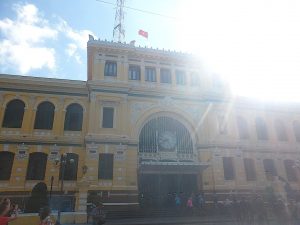
Hanoi to Saigon
While officialdom and the western world refer to Vietnam’s main southern city as Ho Chi Minh City, most inhabitants still call it Saigon. With Emirates flying to both Hanoi and Saigon, it is easy to avoid backtracking by making a ‘one-way’ trip through Vietnam, either by air (my 2h10m flight with Vietnam Airlines was very good), or, if you want to stop off and experience central Vietnam, by train (air conditioned sleeper trains with onboard catering stop at Hue, Danang and Nha Trang on the ‘Reunification’ line), or by bus.
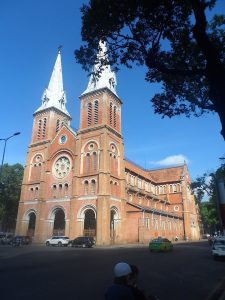
Arriving in Saigon
Saigon’s Tan Son Nhat International Airport is the largest in Vietnam and is just 6km north of the city centre, so the taxi was not so much as in Hanoi – 180,000 dong or €7.34. My hotel had pre-advised me to “make sure that you take one of two brand name taxi companies, Vinasun or Mai Linh, as others will like to cheat you all the time because it is your first time in Ho Chi Minh City”.
Saigon is building a metro but the first line is going to the university, but an overhead road is currently being built from the airport.
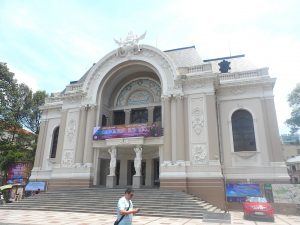
Harmony Saigon Hotel & Spa
Porter and reception at Sunway’s 4-star Harmony Saigon Hotel & Spa at 32A-34 Bui Thi Xuan Street, District 1, Ho Chi Minh City (www.sunway.ie/worldwide-holidays/vietnam/saigon) were friendly and helpful. The De Luxe and Junior Premier Deluxe rooms do not have a view (but are otherwise perfectly fine), so if your client insists on a view they will need to have a Premier Deluxe room or higher.
The Hi Spa is very good and several packages are on offer (www.harmonysaigonhotel.com/en/).
Street Food
Saigon is equally good for street food as Hanoi, so my journalist friend Phung took me to Bun Bo Ganh restaurant at 110 Ly Chinh Thang, P8, Quan 3, and ordered dishes from central Vietnam.
The Cha Gio (fried spring rolls with pork and shrimp) were really delicious, while the Banh Bot Loc (rice dumplings with shrimp and pork) and Goi Cuon (sping rolls in rice wrappers) were good, but I have to confess that I thought the Bun Bo Hue (noodle soup) was better in Hanoi.
The Dau Trang Nuoc Cot Dua (white bean tea with coconut milk) at Lucca, 88 Ho Tung Mau, District 1, was a welcome thirst quencher.
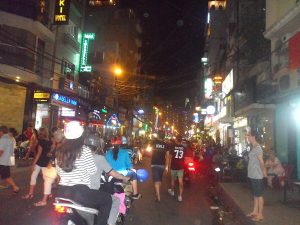
If it’s beer and a ‘lively evening’ that your clients desire, then direct them to Bui Vien Street.
City Tour
My full-day Ho Chi Minh Discovery city tour was well guided by Ni of Intrepid Urban Adventures, who told me that there are around eight million motocyles or scooters in Saigon – one million of which are ridden by foreigners without licences, but the police ignore them.
After a visit to Ben Thanh Market in District 1 (the indoor food market closes at 6.00pm when it becomes an outdoor street market), we visited several French Colonial-style buildings including the Central Post Office, Notre Dame Cathedral and Opera House, but the most interesting place of all was the War Remnants Museum.
With nine permanent thematic exhibitions about the ‘American War’ as it is called, including Historical Truths, War Crimes, and Agent Orange Effects, and various special collections, this museum is a ‘must-see’ for every visitor to Saigon.

It is conventional ‘wisdom’ that the USA entered its ‘Vietnam War’ to prevent the spread of Communism in south-east Asia, rather than having an eye (or two) on valuable resources. However, I noted a quote from President Eisenhower dated 4th August 1953, when the USA voted $400 million to the war, that: “tin and tungsten that we so greatly value from that area would cease coming”.
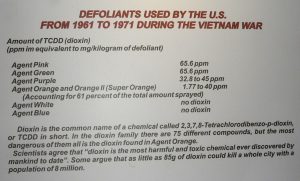
The USA dropped 14.3 million tons of bombs costing US$676 billion on Vietnam (killing three million Vietnamese and injuring another two million) compared to 5.0 million ($341bn) in World War Two and 2.6 million ($54bn) on Korea – along with 80 million litres of toxic chemicals, of which 61% was Agent Orange, sprayed over nearly 26,000 villages. Some 4.8 million Vietnamese people were exposed to Agent Orange and over 3.0 million were its victims. The resulting physical and mental defects – still being endured by fourth generation Vietnamese, as well as GI Veterans and their families – are truly appaling.
Then it was on to the Reunification (or Independence) Palace (top photo), which was the President of South Vietnam’s until a North Vietnames army tank crashed through the gate on 30th April 1975, bringing an end to the American War.
After a delicious lunch of chicken curry, rice and a mango shake at Pho 2000 in Phan Cha Trinh Street (where President Clinton enjoyed Pho noodle soup on 19th November 2000), we visited the early 19th-century Ba Thien Hau Pagoda on Nguyen Trai Street in Chinatown, which has amazing porcelain figures along its roofline.
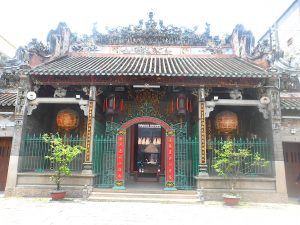
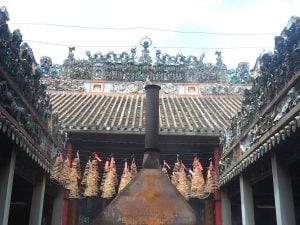
For anyone interested in traditional medicine, another ‘must visit’ is the Fito Museum at 41 Hoang Du Khuong Street, Ward 12, District 10 (www.fitomuseum.com.vn) where some 4,000 minerals, herbs and animal extracts are on display.
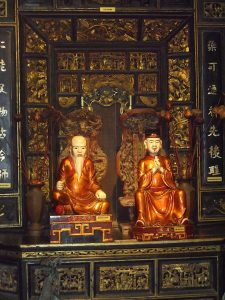
Outside Saigon
If your clients have time to venture outside Hanoi, top attractions to visit on a day tour include the Cu Chi Tunnels, the beach city of Vung Tau, or the Mekong Delta, whose main city is Can Tho with boat trips along surrounding waterways, as well as Tien Giang or Tay Ninh – birthplace of Vietnam’s Cao Dai religion and a place in the life of Phan Thi Kim Phuc, ‘the girl in that photograph’.
Homeward Bound
And so ITTN’s ‘A Tale of Three Cities, Two Countries’ came to an end with my flights home with Emirates from Saigon to Dubai and Dublin, and in-flight catering as good as ever – dinner of Smoked Duck, Prawns with Rice Noodles, and Bank Chuoi Nuong (Vietnamese baked banana pudding) enroute to Dubai, and lunch of Roasted Tomato Soup, Prawn Machbous, and Chocolate Cheesecake to Dublin.
I arrived at Dublin Airport to experience the longest queue at Immigration for EU passports that I have ever seen and my bags were x-rayed by Customs (welcome home!), but Wayne from Devine’s Worldwide Chauffeur Services was waiting in Arrivals, so I re-entered the comfortable world of Emirates for my final journey home to Arklow – even more welcome after a long journey and a bad back from a fall than the start of my round trip to Yangon, Hanoi and Saigon.


